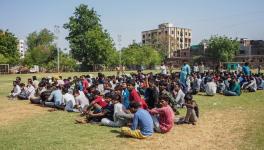Union Govt. Irresponsible Towards At-Risk Citizens in its Ill-Conceived Approach to Fortified Rice
Representational use only.Image courtesy: Flickr
The Alliance for Sustainable and Holistic Agriculture (ASHA) and Right to Food Campaign (RTFC), in a statement, have called out the knee-jerk and self-protecting measures undertaken by the Union government in relation to the distribution of fortified rice in the country under various government schemes.
Two ministries, the Ministry of Food and Public Distribution and the Ministry of Women and Child Development, have resorted to issuing circulars to various state governments to "cover up on an unscientific one-size-fits-all approach to anaemia in the country."
The main issue, as the statement highlights, stems from how the Union government has increased its production and distribution of fortified rice in 2021. This happened while a three-year pilot scheme initiated by the government of India in 2019 in 15 states was still underway. Before the completion of the pilots or evaluation of their findings, the government arbitrarily decided to scale up the distribution of fortified rice to include 257 districts by April 2022.
Various studies have highlighted how rice fortification isn't an effective strategy to tackle anaemia.
"This is apparent from RTI replies from the Union Health Ministry's agency, published papers and credible reviews of published materials. While there are unanswered questions on efficacy, unjustifiable costs and irreversible changes in supply chains in this strategy, there are also serious questions related to the safety and regulation of fortified rice for all citizens. There are statutory regulations notified by the Food Safety and Standards Authority of India (FSSAI regulations of 2018) that have to be complied with by all Food Business Operators, including agencies involved in government food schemes."
Moreover, such products require clear labelling, warning consumers of their potential harm. For instance, thalassemia patients can only consume iron-fortified food under middle supervision, whereas sickle-cell anaemia patients are never to consume such foods.
Moreover, in the case of Sickle Cell Disease (SCD) patients, the sickle-shaped cells within red blood cells break down easily, releasing Iron in circulation; regular destruction of Red Blood Corpuscles (RBCs) results in the build-up of body stores of iron and may lead to liver damage.
"Fortified Rice adds on to the iron stores, which cannot be used for Haemoglobin formation, thus potentially leading to iron overload and organ (liver, endocrine system, heart) damage. In Thalassemia, frequent blood transfusion adds to Iron overload causing cardiac damage, liver fibrosis, reproductive problems, and growth retardation," the statement read.
Despite glaring evidence pointing out the harms of iron consumption in the medical conditions mentioned above, "the Government of India embarked on an ill-conceived and ambitious plan to feed iron-fortified rice to citizens, to tackle anaemia. Such a one-size-fits-all reductionist solution to anaemia ignores numerous conditions specific to our country, and in fact, showcases the disconnect between policy-making and the actual situation of the poor."
Even after the Union government was presented with evidence by ASHA and RTFC, it didn't mend its ways; instead, it chose to escape responsibility by simply issuing circulars to state governments, asking them to "comply".
For instance, the Department of Food and Public Distribution, GoI, has issued several letters to various other departments in the last few months for compliance purposes. An email issued by the department on July 13, 2022, stated, "All States/UTs and FCI were requested therein to bring it to the notice of all concerned and ensure strict compliance" of the FSSAI notification "while distributing fortified rice under TPDS, ICDS, PM-POSHAN schemes and in other welfare schemes. This may be displayed at the Fair Price Shops appropriately along with the posters/banners about fortified rice."
The Ministry of Women and Child Development followed this up with their letter to all state governments on August 1, 2022.
"It is irresponsible of the Union Government to thrust the reckless scheme of rice fortification onto state governments but force them to bear the consequences of the same, including statutory compliances. State Governments have been expressing helplessness in the face of GoI's aggressive push of fortified rice in conversations with civil society groups, that too not from the Health Ministry but unreasonably by the Ministry of Food and Public Distribution", said RTFC and ASHA in their statement.
These circulars, rather than resolving the issue, have compounded it. Consumers in various parts of India will now be "subjected to two different messages being put out at the Fair Price Shops (while it is unclear what babies and children in schools are supposed to do with the new compliance-related circulars) – one that is promotional, and one that displays a statutory regulation."
The statement asks how "in a situation when many citizens with contra-indicated medical conditions do not even know (unscreened/undiagnosed/unaware) that they are not supposed to consume iron-fortified rice, how are such circulars going to help?"
This was confirmed in fact-finding visits by ASHA and RTFC to Jharkhand and Chattisgarh- two states with a high disease burden of Thalassemia.
It was found that "no steps had been taken apart from some lackadaisical compliance at times to the FSSAI labelling regulation, on gunny bags that reach dealer shops. Since the rice is given in the loose form in PDS and cooked form in school/ICDS meals programs, and since many of the patients are illiterate, there was no way for patients to read labels. Moreover, most were undiagnosed since no screening was being done. Such unsuspecting patients were given no warning and were being forced to consume iron-fortified rice as they were poor and couldn't buy non-fortified rice from the market."
India has one of the highest disease burdens of Thalassemia globally, with almost 3.9 crore carriers. It has the largest number of children with β-thalassemia in the world and the highest prevalence of SCD in South Asia.
"India has been ranked the country with the second highest number of predicted SCD births. All such patients are at risk, along with several others who are contra-indicated – such as those with Malaria and Tuberculosis," the statement said.
Get the latest reports & analysis with people's perspective on Protests, movements & deep analytical videos, discussions of the current affairs in your Telegram app. Subscribe to NewsClick's Telegram channel & get Real-Time updates on stories, as they get published on our website.
























